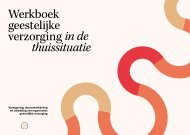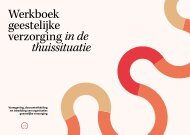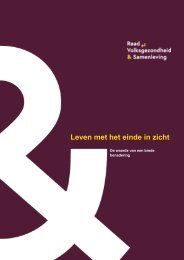Buiten kerk en moskee
Religie in een pluriforme samenleving. Diversiteit en verandering in beeld.
Religie in een pluriforme samenleving. Diversiteit en verandering in beeld.
You also want an ePaper? Increase the reach of your titles
YUMPU automatically turns print PDFs into web optimized ePapers that Google loves.
section, we will look to the future and discuss how developm<strong>en</strong>ts in religious diversity<br />
could affect cleavages and social cohesion in the future.<br />
Socio-cultural cleavages<br />
One way in which a socio-cultural cleavage can manifest itself is in the differ<strong>en</strong>ces in norms<br />
and values that arise from differ<strong>en</strong>ces in the ideological or religious beliefs of Muslims,<br />
Christians and non-believers. The religious cleavage is anything but new. For example, at<br />
the height of pillarisation, there were four groups that had barely any contact with each<br />
other. Each of these groups was united in its own organisations (differ<strong>en</strong>tiation), and their<br />
members felt an emphatic and emotional connection with their own group (id<strong>en</strong>tification).<br />
Each group was also clearly visible as a distinct group in the political world (repres<strong>en</strong>tation).<br />
Thus, the ‘social cleavage’ qualification seemed appropriate at that time. Despite<br />
being a very difficult question to answer – we do not have a crystal ball – we ask ourselves<br />
which socio-cultural cleavages could exist betwe<strong>en</strong> ideological groups in the future based<br />
on curr<strong>en</strong>t insights.<br />
What is oft<strong>en</strong> se<strong>en</strong> as a dominant culture in the Netherlands is unmistakeably increasingly<br />
being characterised by secularisation and, as such, possibly also by individualisation, as the<br />
church and religious communities are now able to exercise less influ<strong>en</strong>ce on the choices<br />
that individuals make and there are no clear substitutes for them yet. Both Christians and<br />
Muslims (and other religious groups) in the Netherlands are regarded as ‘cultural minorities’.<br />
This ‘minority stress’ could explain why we are seeing an increase in religiosity in<br />
young Muslims and young churchgoers in the first two reports of this trilogy. Living in one<br />
of the most secular societies in the world, with views and behaviour that are sometimes<br />
inconsist<strong>en</strong>t with their faith, young Muslims (Huijnk 2018: 16) and young churchgoers (De<br />
Hart and Van Houweling<strong>en</strong> 2018: 54) are more determined to live life in line with their faith<br />
as much as possible. With religious diversity increasing (in comparison with a c<strong>en</strong>tury ago,<br />
for example, wh<strong>en</strong> almost everyone was Christian) and advancing individualisation, further<br />
religious revitalisation – in other words, a more int<strong>en</strong>sive experi<strong>en</strong>ce of faith – would not<br />
seem unlikely. This revitalisation is geographically conc<strong>en</strong>trated too: applying particularly<br />
among young Muslims in specific areas in the (big) cities (Dagevos 2009) and young<br />
churchgoers in the Bible belt. As such, it cannot be ruled out that a deeper socio-cultural<br />
cleavage could develop betwe<strong>en</strong> these religious groups and the rest of the Netherlands –<br />
which is predominantly and probably also increasingly more secular. Regionalisation could<br />
be an additional factor in this. Bridging and other contact betwe<strong>en</strong> individuals in these<br />
groups could blur cleavages.<br />
The question is whether the cleavage betwe<strong>en</strong> believers, Muslims and Christians in particular<br />
will be as visible and pat<strong>en</strong>t as that betwe<strong>en</strong> believers and non-believers. As orthodox<br />
or other believers, they share a number of interests in a society that is otherwise predominantly<br />
secular and becoming more and more so. For example, Jews and Muslims joined<br />
forces with each other against the ban on ritual slaughter, and Christian leaders have indicated<br />
they understand the emotions Muslims feel wh<strong>en</strong> the Prophet is insulted (Cliteur<br />
159 c o n c l u d i n g r e m a r k s o n t h r e e r e p o r t s










